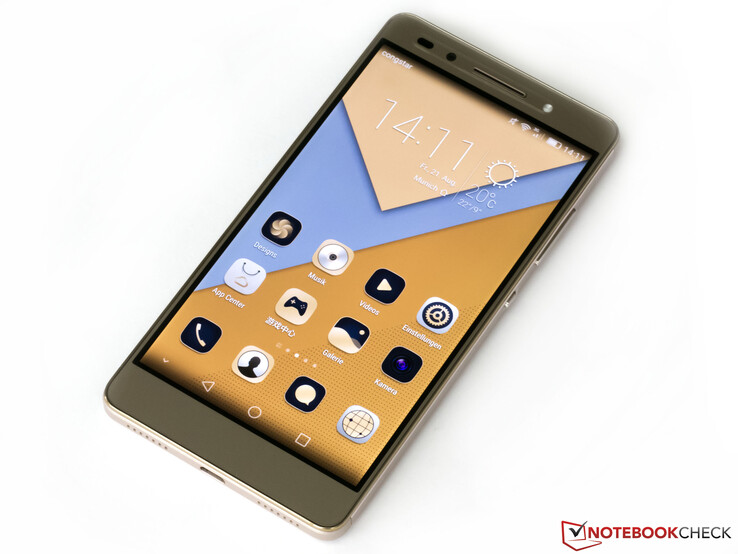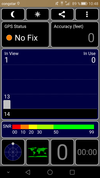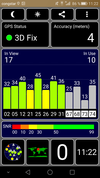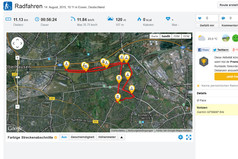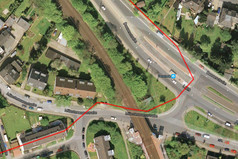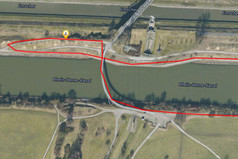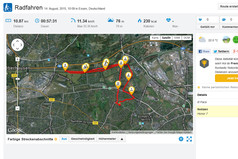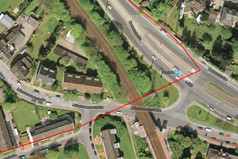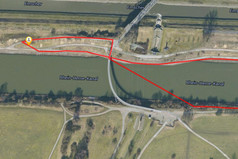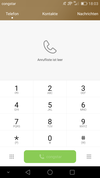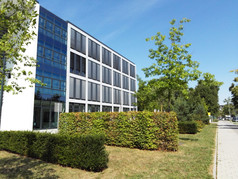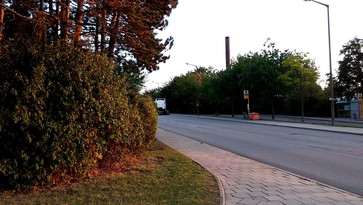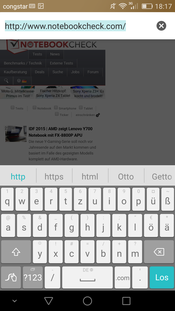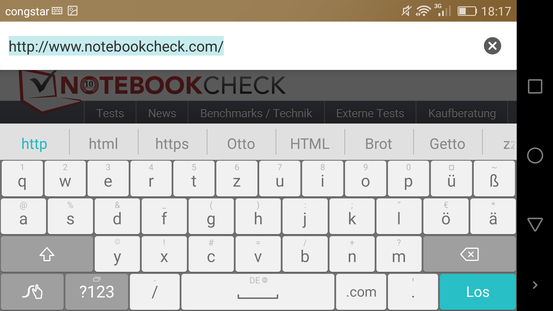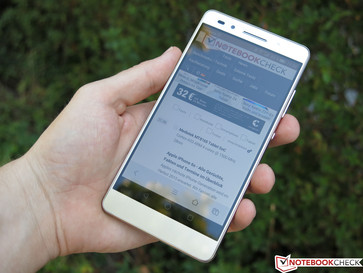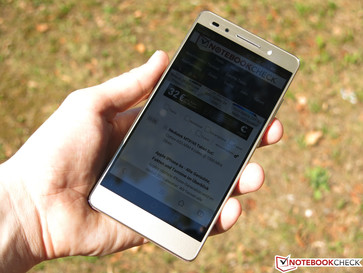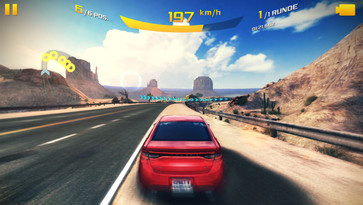Honor 7 Smartphone Review

For the original German review, see here.
The Honor 7 has already been available in China for a few weeks and created some news before its launch: There were more than 9 million pre-orders for the smartphone (we reported). This might also be a result of the comparatively low price of about 360 Euros (~$405) for the 64 GB version. The retail price of the smartphone had not been announced at the time of the review, but we expect something between 400 and 450 Euros (~$450 and ~$506). We should get more information after the European launch on August 27th (see update at the end of the review). We obtained the review unit from the importer Tradingshenzhen.
Honor is the subsidiary of the telecommunication giant Huawei, so it is not really surprising that the technical specifications of the review unit show similarities to the company sibling Huawei P8. Both models feature 3 GB of memory, a 5.2-inch Full HD display as well as a Kirin octa-core processor. The latter is even 200 MHz faster in the Honor 7. Another difference concerns the flash storage: Our review unit offers a generous capacity of 64 GB, while the P8 is only available with 16 GB in Europe. Both smartphones use Android Lollipop with Huawei’s own EMUI 3.1 user interface. The display size is 0.2 inches larger than the Honor 6.
In addition to the Huawei P8, other rivals for the Honor 7 are mainly other flagship devices such as the LG G4 or Samsung's Galaxy S6. If you prefer another operating system, you might want to have a look at the Lumia 930 with Windows or the Apple iPhone 6 Plus, for example.
Case
The new model is larger than the Honor 6 in every aspect, which is probably a result of the larger display. Honor specifies the thickness of the device at 8.5 millimeters (~0.33 in), but the clearly protruding camera at the back is not included and adds an extra 1.5 millimeters (~0.06 in). This means that the Honor 7 is noticeably thicker than Samsung's Galaxy S6 or Huawei's P8, for instance, without appearing too bulky. At 161 grams (~5.7 oz), the review unit is also slightly heavier than many smartphones with similar display sizes: Only the much larger iPhone 6 Plus and the Nokia Lumia 930 are slightly heavier among the comparison group.
The smartphone does leave a sturdy impression. You can notice some flexing when you twist the device, but fortunately, there are no creaking sounds or picture distortions. The back of the device is relatively pressure resistant, while the display can be slightly pushed in. However, this does not affect the picture quality. The build quality of the test model does not reveal any serious issues: All gaps are even, and the used materials are sophisticated. While most of the back panel and the two long side edges are made of metal, the upper and lower peripheral areas are made of plastic that uses an appealing texture in some areas. The only criticism might be the uneven color impressions from various angles due to the different reflectivity. The device does not have a detachable back cover, so users cannot replace the battery.
Overall, the focus during the development of the Honor 7 was probably not so much a slim construction, but more of a sophisticated as well as robust chassis.
Connectivity
Equipped with the octa-core SoC. HiSilicon Kirin 935 and 3 GB of memory, the specifications of the components are on par with the high-end competition. You also get 64 GB of flash storage, of which 52 GB can be used for your own files ex-works.
Unlike the versions of the Huawei P8 that are currently available in Europe, the Honor 7 has a dual-SIM feature. You can use up to two Nano-SIM cards, but the second slot can also be equipped with a microSD-card (up to 128 GB). If you decide to use the latter, it is also possible to transfer applications from the smartphone to the memory card.
It is somewhat unfortunate that the Honor 7 does not have a modern USB 3.0 port, which means you can only use the common Micro-USB 2.0 port. However, this is not the exception since unfortunately, many other smartphone manufacturers also do not use the current port for their new devices. On the other hand, you get support for USB-OTG, so it is not an issue to attach external storage devices. Other included features are an FM radio, NFC; Bluetooth 4.1 as well as media streaming via DLNA. A multi-color notification LED is located in the speaker opening above the display.
A small highlight of the Honor 7 is the fingerprint reader at the back. We are already familiar with this from the Huawei Ascend Mate 7. It worked really well during our review period and allows a very fast activation and unlocking of the smartphone. Another handy feature is the integration of an infrared transmitter, so devices like TVs or DVD players can be controlled with an app.
Software
The operating system is Android 5.02 with Huawei’s familiar user interface EMUI 3.1. This dispenses with the otherwise common app drawer, so all installed apps are directly shown on the home screen. Obviously, you can still create folders to avoid chaos, and you can even scroll them when the number of apps exceeds 9.
The importer has already deleted the Chinese apps and the Google Play Store can be used, but these changes will be gone when you reset the system. However, this is not a big problem, because all menus will be available in German after you have changed the corresponding setting. It is also easy to delete almost all the Chinese apps. The only app that remains is the "Private Newsfeed", which can be accessed by a swipe to the left on the home screen (can be deactivated) as well as the "App Center", which is a system application and cannot be removed. The installation of the Google Play Store is easy via APK file, and other Google services can be installed after that.
The modified Android user interface implements numerous small improvements. These include, among others, the optional double-tap-to-wake function as well as the handy shortcuts on the lock screen. They can be faded in with a swipe from the bottom and allow the use of some apps (voice recorder, calculator, flashlight, and camera) without having to unlock the device first. It is also possible to use a gesture control, where the drawing of certain numbers on the deactivated display will launch previously defined apps. Less experienced users can also select an alternative user interface that limits the functionality of the smartphone to the most important things. It is also easier to use, thanks to enlarged icons. Another handy aspect is that Honor already integrates an authentication manager, which will only be a standard feature with the upcoming Android 6.0.
Communication & GPS
The wireless module of the Honor 7 supports all common GSM and 3G bands in Germany. LTE Cat. 6 at up to 300 Mbps (downstream) and 50 Mbps (upstream) is available, but our import device does not support the commonly used 800 MHz band in Germany. It is possible that the European version will support it. There was no criticism for the signal quality; it was on par with similar devices.
Unlike the Huawei P8, the Wi-Fi module of the Honor 7 supports both 2.4 GHz networks as well as 5 GHz bands (a/b/g/n/ac). We managed a connection up to 433 Mbps (gross) in combination with an Asus RT-AC56U router. The signal quality was good, but the range was slightly better in the 2.4 GHz network. NFC and Bluetooth 4.1 are included.
The GPS module will find the current position very quickly outdoors, but we could not locate the device on the third floor of a four-story apartment building.
We checked the accuracy of the Honor 7 on a bicycle ride and compared it with the navigation device Garmin GPSMAP 64s. The smartphone determined an overall track length of 10.87 kilometers (~6.75 mi), while the Garmin device showed 11.13 km (~6.9 mi). The difference of around 2.3% is similar to other rivals like the Samsung Galaxy S6. The reason for the difference compared to the Garmin is the less precise location, which is evident when you look at the pretty linear track (see the picture of the crossing). However, the GPS module of the Honor 7 works well in practice.
Telephone & Voice Quality
As well as dialing function, the simple phone app also gives you access to contacts, a chronologically sorted caller history as well as direct access to SMS and MMS messages.
Voices are easy to understand on both sides of the call, although there were some occasional background noises at the end of a sentence on the landline side. Nothing really changes for the smartphone’s user when he uses the hands-free feature: Thanks to the loud and pretty natural sound, it was easy to understand the other person. However, our voice was slightly quieter on the other side. Still, this is just a minor issue, so we can confirm a good impression in terms of the call quality.
Cameras & Multimedia
The Honor 7 has a 20 MP camera at the back as well as an 8 MP selfie cam, so the review unit can secure the first spot in this comparison in terms of pixel count. Some rivals also take high-resolution pictures, but the combination of high-resolution front and main camera is unrivaled.
One highlight of the rear camera is the phase detection autofocus, which is supposed to ensure faster focusing. Unfortunately, an optical image stabilizer is not included, even though this can be somewhat compensated for by the maximum aperture of f/2.0. The camera of the Honor 7 is supported by a two-color flash at the back in darker environments. Only the upper cold-white LED of the review unit worked at the full luminance, so the flashlight was blueish and just moderately bright.
However, what can you expect from the 20 MP camera in practice? There is not really a noticeable advantage over conventional autofocusing methods in terms of the triggering speed, even though the Honor 7 takes pictures immediately in good lighting conditions. The focusing takes a little longer in darker environments, which means a laser-based system from the LG G3, for example, is slightly faster. In general, the pictures impress with a high resolution, which is visible when you look at the building in the background of the second comparison picture. However, despite the nominally lower pixel count, the Samsung Galaxy S6 managed even sharper pictures. This small advantage also translates into the performance of the white balance and exposure, which is evident by the greater similarity to the reference shots with the Canon DSLR. That the high-resolution camera of the Honor 7 does not have only advantages is also shown by the clearly visible picture noise when you zoom in. It is also slightly noticeable when the lighting is good, but is obviously more pronounced in unfavorable conditions. This observation is also confirmed by our third comparison picture, where the Samsung Galaxy S6 picture shows less noise without washed-out details. Therefore, the highest pixel number does not ensure an unbeatable picture quality, but the pictures of the Honor 7 camera can still impress with a high resolution and pretty natural colors.
The Honor 7 uses an 8 MP camera for selfies with a focal length of 26 millimeters (~1 in) and a maximum aperture of f/2.4. The pictures are quite good for a front camera, but the depth of field is limited by the missing autofocus (see example picture). However, this is not so important for selfies. The two-stage warm-white LED at the front is also handy and can provide a slightly better illumination in very dark environments.
The volume button can be reassigned with a trigger, zoom or focus function, so it is possible to take pictures without touching the screen, for instance. Honor has also implemented a feature for snapshots, which allows taking pictures from standby after 1 to 2 seconds. You just have to quickly push the volume down button twice when the display is deactivated. It is rather unfortunate that the autofocus does not work in this mode, so close-ups will not be a huge success.
As well as several live-effect filters, the Camera app offers a special mode to improve "food pictures" as well as the light painting that is already familiar from the Huawei P8. Creative minds can use light sources – like a flashlight – to "paint" directly into the picture.
The main camera of the Honor 7 takes videos in the Full HD resolution at 30 frames per second. Other models, like the LG G4, already offer UHD recordings. The quality is still sufficient for most scenarios, but the videos lack the last bit of details compared to the high-end devices. You also get a slow-motion function that takes 720p videos at around 100 frames per second. Unfortunately, these recordings are not completely smooth during playback and leave a rather pixelated impression. Another drawback is that there is no automatic refocusing during movements, not even as an option. However, it is possible to adjust the focus manually by touching the corresponding area on the display.
The front camera can also record videos in Full HD, but only at 27 fps. The results still look pretty smooth, but the sharpness cannot compete with the main camera of the Honor 7.
Sound is recorded in stereo and is generally quite natural, but we were able to hear a recurring clicking in quiet environments within the audio track.
Accessories
Our Honor 7 was delivered in a nice plastic box, which also left a very sturdy impression. One element from the two inner parts can be used as a kind of stand for the smartphone, which can be used to place it at a 45-degree angle – a clever idea.
The box also includes a powerful 10-watt power adaptor, but it does not suit the European socket. You also get a USB cable as well as several brochures, but no headset.
Warranty
The shop offers the full manufacturer's warranty when you import the device via Tradingshenzhen. This period is twelve months.
Input Devices & Handling
The front of the Honor 7 is made entirely of glass, which is surrounded by a golden frame. Our review unit also came with a mounted protective display cover. It already showed some scratches after a short while, but the fingers still glide very easily across the display surface.
The physical buttons have firm pressure points and are well integrated into the chassis. It is handy that Honor has integrated an additional button besides the volume rocker and the power button. It can be used for different actions like the activation of the flashlight or taking a screenshot.
Text inputs are possible via the default Huawei's Swype keyboard, but it is also possible to use Google's standard input. The former input method does, however, offer some advantages like direct inputs of umlauts (when you select the German layout), an adjustable keyboard height as well as several gesture controls.
The system reacts quickly to inputs and the user experience is pretty smooth. However, not all animations are buttery smooth and there are occasionally micro stutters – but they are only a problem when you have a closer look, so many users will hardly notice them. The display rotation is fast and without any delays, and touchscreen inputs are executed accurately.
Display
The Honor 7 is equipped with a 5.2-inch IPS display in a 16:9 aspect ratio and a native resolution of 1920x1080 pixels. At 424 ppi, the pixel density is standard for this device class, although some rivals like the Samsung Galaxy S6, for example, manage even higher results. However, these are not necessary for a sharp picture anyway, because you cannot see any pixel structures on the Full HD panel of the Honor 7 at normal viewing distances.
A brightness of 442 cd/m² for the review unit is not a new record, but is average in comparison. LG's G4 and Apple's iPhone 6 Plus in particular are even brighter. The brightness distribution of 92% on the other hand is very even.
| |||||||||||||||||||||||||
Brightness Distribution: 92 %
Center on Battery: 442 cd/m²
Contrast: 1922:1 (Black: 0.23 cd/m²)
ΔE ColorChecker Calman: 4.52 | ∀{0.5-29.43 Ø4.78}
ΔE Greyscale Calman: 5.47 | ∀{0.09-98 Ø5}
99.7% sRGB (Argyll 1.6.3 3D)
Gamma: 2.27
CCT: 7874 K
| Honor 7 1920x1080 px 5.2'' (IPS) | Honor 6 1920x1080 px 5.0'' (IPS) | Huawei P8 1920x1080 px 5.2'' (IPS-NEO) | LG G4 2560x1440 px 5.5'' (Quantum-IPS) | Samsung Galaxy S6 2560x1440 px 5.1'' (Super-AMOLED) | Nokia Lumia 930 1920x1080 px 5.0'' (AMOLED) | Apple iPhone 6 Plus 1920x1080 px 5.5'' (Retina) | |
|---|---|---|---|---|---|---|---|
| Screen | |||||||
| Brightness middle (cd/m²) | 442 | 439 -1% | 453 2% | 566 28% | 335 -24% | 275 -38% | 519 17% |
| Brightness (cd/m²) | 440 | 439 0% | 439 0% | 536 22% | 345 -22% | 278 -37% | 496 13% |
| Brightness Distribution (%) | 92 | 93 1% | 91 -1% | 90 -2% | 89 -3% | 89 -3% | 90 -2% |
| Black Level * (cd/m²) | 0.23 | 0.8 -248% | 0.28 -22% | 0.47 -104% | 0.62 -170% | ||
| Contrast (:1) | 1922 | 549 -71% | 1618 -16% | 1204 -37% | 837 -56% | ||
| Colorchecker dE 2000 * | 4.52 | 7.06 -56% | 4.7 -4% | 6.17 -37% | 2.51 44% | 10.99 -143% | 3.67 19% |
| Greyscale dE 2000 * | 5.47 | 8.08 -48% | 5.03 8% | 6.26 -14% | 2.59 53% | 8.29 -52% | 3.78 31% |
| Gamma | 2.27 97% | 2.16 102% | 2.27 97% | 2.48 89% | 2.43 91% | 2.16 102% | 2.42 91% |
| CCT | 7874 83% | 8134 80% | 7439 87% | 8171 80% | 6424 101% | 6731 97% | 7327 89% |
| Color Space (Percent of sRGB) (%) | 99.7 | 98.63 -1% | |||||
| Color Space (Percent of AdobeRGB 1998) (%) | 72.04 | 65.48 |
* ... smaller is better
The display of the Honor 7 manages an extremely high contrast of 1922:1, which is mainly a result of the low black value at just 0.23 cd/m² – no LC panel has been better in our tests. Even the internal competition in the form of the Huawei P8 cannot quite keep up with its good IPS-NEO display. Only AMOLED displays have an advantage in this section, where the black value is 0 cd/m² due to the technology. The subjective impression of the display is very rich and brilliant.
We use the software CalMAN as well as a spectrophotometer for a further analysis and determine average DeltaE deviations of 4.52 (ColorChecker) and 5.47 (Grayscale), respectively. These results cannot compete with the best devices, but are still decent (ideal value: DeltaE <3). We can see improvements compared to the Honor 6 in particular. While a gamma value of 2.27 is very close to the ideal value, the color temperature is slightly too high at 7874 K. The CalMAN measurements also show an sRGB color space coverage of 99.6%.
Thanks to the excellent contrast and the decent luminance, the Honor 7 is well suited for outdoor use. The visibility is noticeably affected under direct sunlight, but it is usually easy to find a favorable viewing angle and see the display content. You will only have some problems with reflections on the touchscreen in the shade, which is typical for smartphones.
There is not much criticism for the viewing angle stability of the display. Colors remain stable even from flat angles and there are no color inversions. The brightness is reduced slightly when you look at the panel from the side, but this does not affect its usability. An IPS glow effect, which is characterized by brightened up dark areas, is only visible from very flat diagonal viewing angles and should therefore not be a big issue in practice.
Performance
Inside the Honor 7 is a HiSilicon Kirin 935 SoC, which is closely related to the Kirin 930 SoC in the Huawei P8. It consists of two quad-core clusters in a big.Little configuration, where one cluster runs at 1.5 and the other one at 2.2 GHz (Kirin 930 up to 2.0 GHz). This SoC uses the rather slow Cortex-A53 cores, so the single-core performance cannot keep up with the best devices. The situation is better in multi-core scenarios, which is confirmed by the Linpack benchmark, for example: While even the older Kirin 920 SoC of the Honor 6 beats the supposedly more modern Kirin 935 of the Honor 7 in the single-core test, it is the opposite in the multi-core benchmark. Therefore, it is not surprising that the review unit is only average in the CPU focused benchmarks, despite the high nominal clocks. It can usually beat the Honor 6, but is also a little faster than the Huawei P8 thanks to the slightly higher clocks. However, it does not achieve the performance level of a Samsung Galaxy S6 or S6 Edge .
The SoC also includes a Mali-T628 GPU that we are already familiar with from the Honor 6. It is a mainstream chip, but the performance in the case of the Honor 7 is quite disappointing. Both the review unit and the Huawei P8, which uses the same GPU, usually occupy the last places both in the GFXBench T-Rex test and 3DMark. It is interesting that the older Honor 6 with the same GPU performed much better. The review also quickly showed that the benchmark results could drop by up to 15% in the third run, which indicates a reduction of the CPU or GPU clock and could explain the better results of the Honor 6. A positive aspect on the other hand, is the support for the current graphics standards OpenGL ES 3.0 and 3.1.
| AnTuTu v5 - Total Score (sort by value) | |
| Honor 7 | |
| Huawei P8 | |
| Honor 6 | |
| LG G4 | |
| Samsung Galaxy S6 | |
| Samsung Galaxy S6 Edge | |
| Apple iPhone 6 Plus | |
| Geekbench 3 | |
| 64 Bit Multi-Core Score (sort by value) | |
| Honor 7 | |
| Huawei P8 | |
| LG G4 | |
| Samsung Galaxy S6 Edge | |
| 64 Bit Single-Core Score (sort by value) | |
| Honor 7 | |
| Huawei P8 | |
| LG G4 | |
| Samsung Galaxy S6 Edge | |
| Linpack Android / IOS | |
| Multi Thread (sort by value) | |
| Honor 7 | |
| Huawei P8 | |
| Honor 6 | |
| LG G4 | |
| Samsung Galaxy S6 Edge | |
| Nokia Lumia 930 | |
| Apple iPhone 6 Plus | |
| Single Thread (sort by value) | |
| Honor 7 | |
| Huawei P8 | |
| Honor 6 | |
| LG G4 | |
| Samsung Galaxy S6 Edge | |
| Nokia Lumia 930 | |
| Apple iPhone 6 Plus | |
| Smartbench 2012 | |
| Gaming Index (sort by value) | |
| Honor 7 | |
| Huawei P8 | |
| Honor 6 | |
| LG G4 | |
| Samsung Galaxy S6 Edge | |
| Productivity Index (sort by value) | |
| Honor 7 | |
| Huawei P8 | |
| Honor 6 | |
| LG G4 | |
| Samsung Galaxy S6 Edge | |
| PCMark for Android - Work performance score (sort by value) | |
| Honor 7 | |
| Huawei P8 | |
| Honor 6 | |
| LG G4 | |
| Samsung Galaxy S6 Edge | |
| GFXBench (DX / GLBenchmark) 2.7 | |
| T-Rex Onscreen (sort by value) | |
| Honor 7 | |
| Huawei P8 | |
| Honor 6 | |
| LG G4 | |
| Samsung Galaxy S6 | |
| Samsung Galaxy S6 Edge | |
| Nokia Lumia 930 | |
| Apple iPhone 6 Plus | |
| 1920x1080 T-Rex Offscreen (sort by value) | |
| Honor 7 | |
| Huawei P8 | |
| Honor 6 | |
| LG G4 | |
| Samsung Galaxy S6 | |
| Samsung Galaxy S6 Edge | |
| Nokia Lumia 930 | |
| Apple iPhone 6 Plus | |
| 3DMark | |
| 1280x720 offscreen Ice Storm Unlimited Score (sort by value) | |
| Honor 7 | |
| Huawei P8 | |
| Honor 6 | |
| LG G4 | |
| Samsung Galaxy S6 | |
| Samsung Galaxy S6 Edge | |
| Apple iPhone 6 Plus | |
| 1280x720 offscreen Ice Storm Unlimited Graphics Score (sort by value) | |
| Honor 7 | |
| Huawei P8 | |
| Honor 6 | |
| LG G4 | |
| Samsung Galaxy S6 | |
| Samsung Galaxy S6 Edge | |
| Apple iPhone 6 Plus | |
| 1280x720 offscreen Ice Storm Unlimited Physics (sort by value) | |
| Honor 7 | |
| Huawei P8 | |
| Honor 6 | |
| LG G4 | |
| Samsung Galaxy S6 | |
| Samsung Galaxy S6 Edge | |
| Apple iPhone 6 Plus | |
The browsing tests are very similar to the gaming benchmarks: Both the review unit and the Huawei P8 are usually at the bottom of the rankings, while the Honor 6 can beat them both. Apple's iPhone 6 Plus, the LG G4 as well as Samsung’s Galaxy S6 and S6 Edge are much better. Subjectively, however, you cannot notice the mediocre performance of the review unit; web browsing is possible without noticeable delays.
| Octane V2 - Total Score (sort by value) | |
| Honor 7 | |
| Honor 6 | |
| Huawei P8 | |
| LG G4 | |
| Samsung Galaxy S6 | |
| Samsung Galaxy S6 Edge | |
| Nokia Lumia 930 | |
| Apple iPhone 6 Plus | |
| Sunspider - 1.0 Total Score (sort by value) | |
| Honor 7 | |
| Honor 6 | |
| Huawei P8 | |
| LG G4 | |
| Samsung Galaxy S6 | |
| Samsung Galaxy S6 Edge | |
| Nokia Lumia 930 | |
| Apple iPhone 6 Plus | |
| Mozilla Kraken 1.1 - Total (sort by value) | |
| Honor 7 | |
| Honor 6 | |
| Huawei P8 | |
| LG G4 | |
| Samsung Galaxy S6 Edge | |
| Nokia Lumia 930 | |
| Apple iPhone 6 Plus | |
| WebXPRT 2015 - Overall (sort by value) | |
| Honor 7 | |
| Huawei P8 | |
| LG G4 | |
| Google V8 Ver. 7 - Google V8 Ver. 7 Score (sort by value) | |
| Honor 7 | |
| Honor 6 | |
| Huawei P8 | |
| LG G4 | |
| Samsung Galaxy S6 Edge | |
| Apple iPhone 6 Plus | |
| JetStream 1.1 - Total Score (sort by value) | |
| Honor 7 | |
| LG G4 | |
| Samsung Galaxy S6 | |
| Samsung Galaxy S6 Edge | |
* ... smaller is better
The generous flash storage of the Honor 7 has 64 GB of storage and is noticeably faster than the Honor 6. Quite often the results are on par with the Huawei P8 – the Honor 7 benefits from the larger storage capacity only when it writes larger files and manages a higher transfer rate. Once again, the top models from Samsung and LG can impress with much faster performance results.
| AndroBench 3-5 | |
| Random Write 4KB (sort by value) | |
| Honor 7 | |
| Honor 6 | |
| Huawei P8 | |
| LG G4 | |
| Samsung Galaxy S6 | |
| Samsung Galaxy S6 Edge | |
| Random Read 4KB (sort by value) | |
| Honor 7 | |
| Honor 6 | |
| Huawei P8 | |
| LG G4 | |
| Samsung Galaxy S6 | |
| Samsung Galaxy S6 Edge | |
| Sequential Write 256KB (sort by value) | |
| Honor 7 | |
| Honor 6 | |
| Huawei P8 | |
| LG G4 | |
| Samsung Galaxy S6 | |
| Samsung Galaxy S6 Edge | |
| Sequential Read 256KB (sort by value) | |
| Honor 7 | |
| Honor 6 | |
| Huawei P8 | |
| LG G4 | |
| Samsung Galaxy S6 | |
| Samsung Galaxy S6 Edge | |
Games
Even though the Mali-T628 GPU did not produce the most convincing results in the synthetic benchmarks, the Honor 7 can actually manage smooth gameplay in current and complex games. The racing game "Asphalt 8", for example, can be played at medium settings. The frame rate will take a noticeable drop when you switch to high settings, but there is still no real stuttering. Less demanding apps like "Angry Birds" are therefore not a problem for the smartphone.
The integrated position sensors as well as the precise touchscreen also left a good impression during gaming. The location of the speakers is rather unfavorable, which is often covered by the right hand when you hold the smartphone in landscape mode. The only solution will be turning the device by 180 degrees.
Emissions
Temperature
We can already measure temperatures higher than 40 °C (~104 °F) in some spots of the chassis while idling, so the Honor 7 gets unusually warm for this scenario and all the rivals are much better. Fortunately, the temperatures will not get much higher under load, so the highest result of 44.8 °C (~113 °F) is not critical, but clearly higher than the average. We measured around 10 °C (~18.4 °F) less on the Huawei P8, despite the similar components and the much slimmer chassis. Only the Nokia Lumia 930 is even warmer than the Honor 7.
We checked the behavior of the review unit under sustained load with the GFXBench Battery test. It repeats the T-Rex-Onscreen benchmark thirty times. The frame rate diagram does not show a good performance: The frame rate dropped by around 15% after the fourth run, and by another 15% four runs later. This shows a clear performance decrease, which was already noticeable in the 3DMarks.
(±) The maximum temperature on the upper side is 44.8 °C / 113 F, compared to the average of 35.2 °C / 95 F, ranging from 21.9 to 247 °C for the class Smartphone.
(+) The bottom heats up to a maximum of 36.4 °C / 98 F, compared to the average of 34 °C / 93 F
(±) In idle usage, the average temperature for the upper side is 37 °C / 99 F, compared to the device average of 32.9 °C / 91 F.
Speaker
While the two similar looking grilles at the bottom of the smartphone suggest a dual-speaker system, you actually just get one speaker on the left side. However, it can impress with a pretty good sound: The maximum volume should be sufficient for many applications, and both music as well as voices are quite natural and free of distortions. You can even notice some bass; some notebooks offer worse speakers.
The review unit was not shipped with a headset, but we can still confirm a very good sound quality for the stereo jack. The maximum volume is also very high.
Energy Management
Power Consumption
Unfortunately, the Honor 7 is not very impressive in terms of power consumption. There are not many rivals that need more power in the individual test sections. The review unit consumes the most power by a big margin while idling, but the LG G4 is worse under medium workloads. We also noticed a heavily fluctuating maximum consumption between 5.7 watts and extremely high 10.6 watts, so we used the average value for our database.
The provided power adaptor has a nominal output of 10 watts (5 V, 2 A), but did not have a European connector. The device can be charged in less than 2 hours with a similarly powerful adaptor, and the battery capacity reaches 60% after one hour. This means that despite the larger battery, the charging time is much shorter compared to the similar Huawei P8.
| Off / Standby | |
| Idle | |
| Load |
|
Key:
min: | |
| Honor 7 Mali-T628 MP4, Kirin 935, 64 GB eMMC Flash | Huawei P8 Mali-T628 MP4, Kirin 930, 16 GB eMMC Flash | Honor 6 Mali-T628 MP4, Kirin 920, 16 GB eMMC Flash | LG G4 Adreno 418, 808 MSM8992, 32 GB eMMC Flash | Samsung Galaxy S6 Mali-T760 MP8, Exynos 7420, 32 GB UFS 2.0 Flash | Nokia Lumia 930 Adreno 330, 800 MSM8974, 32 GB eMMC Flash | Apple iPhone 6 Plus PowerVR GX6450, A8, 64 GB eMMC Flash | |
|---|---|---|---|---|---|---|---|
| Power Consumption | |||||||
| Idle Minimum * (Watt) | 1.7 | 0.7 59% | 1.7 -0% | 1.1 35% | 0.4 76% | 1.1 35% | 0.5 71% |
| Idle Average * (Watt) | 2.9 | 2 31% | 2.4 17% | 1.5 48% | 0.6 79% | 1.4 52% | 2.1 28% |
| Idle Maximum * (Watt) | 3.3 | 2.1 36% | 2.8 15% | 1.9 42% | 1.2 64% | 1.8 45% | 2.5 24% |
| Load Average * (Watt) | 4.9 | 4.9 -0% | 5.3 -8% | 6.6 -35% | 5 -2% | 3.8 22% | 3.5 29% |
| Load Maximum * (Watt) | 8.2 | 7.4 10% | 6.8 17% | 8.8 -7% | 6.8 17% | 6.5 21% | 5.8 29% |
* ... smaller is better
Battery Runtime
Thanks to the comparatively generous battery capacity of 11.8 Wh, the runtimes of the Honor 7 are quite good, despite the high power consumption. The realistic Wi-Fi test in particular determines a very good runtime of 8 hours and 4 minutes, which is only beaten by the Nokia Lumia 930 as well as the Apple iPhone 6 Plus. However, these two devices were tested with the older Wi-Fi test that was less demanding, so the results are not really comparable. The playback of the movie "Big Buck Bunny" stopped after 9 hours and 13 minutes, which is also a decent result. Other devices like the LG G4 or the Huawei P8 are on a very similar level, while the iPhone 6 Plus lasts 22% lower. The idle runtime of the Honor 7 cannot keep up with the rivals – the bad efficiency is noticeable in this scenario. It is still positive that the runtimes were improved compared to the Honor 6.
The Honor 7 also has an ultra-energy-saving mode for emergencies that can increase the battery runtime by a few minutes. However, you should bear in mind that it limits the functionality of the smartphone to calls and text messages.
| Honor 7 Mali-T628 MP4, Kirin 935, 64 GB eMMC Flash | Huawei P8 Mali-T628 MP4, Kirin 930, 16 GB eMMC Flash | Honor 6 Mali-T628 MP4, Kirin 920, 16 GB eMMC Flash | LG G4 Adreno 418, 808 MSM8992, 32 GB eMMC Flash | Samsung Galaxy S6 Mali-T760 MP8, Exynos 7420, 32 GB UFS 2.0 Flash | Nokia Lumia 930 Adreno 330, 800 MSM8974, 32 GB eMMC Flash | Apple iPhone 6 Plus PowerVR GX6450, A8, 64 GB eMMC Flash | |
|---|---|---|---|---|---|---|---|
| Battery runtime | |||||||
| Reader / Idle (h) | 14.8 | 13.8 -7% | 27.6 86% | 21.7 47% | 23.1 56% | 23.9 61% | |
| H.264 (h) | 9.2 | 9.7 5% | 8.4 -9% | 11.3 23% | |||
| WiFi v1.3 (h) | 8.1 | 7.2 -11% | 5.4 -33% | 7.9 -2% | |||
| Load (h) | 4 | 3.6 -10% | 2.2 -45% | 1.9 -52% | 4.6 15% | 2.9 -27% | 3.3 -17% |
| WiFi (h) | 7.6 | 9.6 | 16.7 | 13 |
Pros
Cons
Verdict
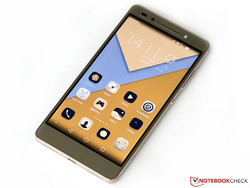
The Honor 7 is a very convenient all-rounder with many advantages. Besides the extremely high-contrast display, which also scores with a decent luminance and wide viewing angles, the review unit is very well equipped: Thanks to 64 GB of internal storage, fingerprint reader, dual-SIM feature and AC Wi-Fi, it clearly beats the review version of the company sibling Huawei P8. Honor has also implemented a storage expansion via microSD-card. However, this means you cannot use a second SIM card.
The general impression of the camera module is positive. The main camera takes very detailed pictures and offers numerous filters as well as shooting modes. On the other hand, the picture noise that can be an issue under good lighting conditions is an inconvenience. The selfie camera on the front also works well and has an additional LED that can be very useful in dark environments. Both cameras record videos in Full HD – some rivals offer more in this respect.
The performance of the SoC on the other hand is rather disappointing. Despite the high clocks, the octa-core is not even close to the best devices, but the further reduced performance under sustained load is an even bigger issue. Fortunately, this is not that big of a deal in practice, which cannot be said about the quite high power consumption that prevents even better runtimes for the Honor 7. Our import version also lacked the support for 800 MHz LTE.
The Honor 7 is therefore a good alternative to the similarly positioned Huawei P8 and has advantages in terms of the comprehensive features as well as the battery runtimes. However, customers will have to dispense with the slim construction of the P8.
The retail price should be interesting when the device is launched in Europe.
Update 08/28/2015: The manufacturer has released information about the European model of the Honor 7 by now (we reported). Unlike our review unit, the European model will be available with only 16 GB of storage, although it will support the 800 MHz LTE band. The list price is relatively cheap at 350 Euros (~$394).
Honor 7
- 08/27/2015 v4 (old)
Andreas Kilian




